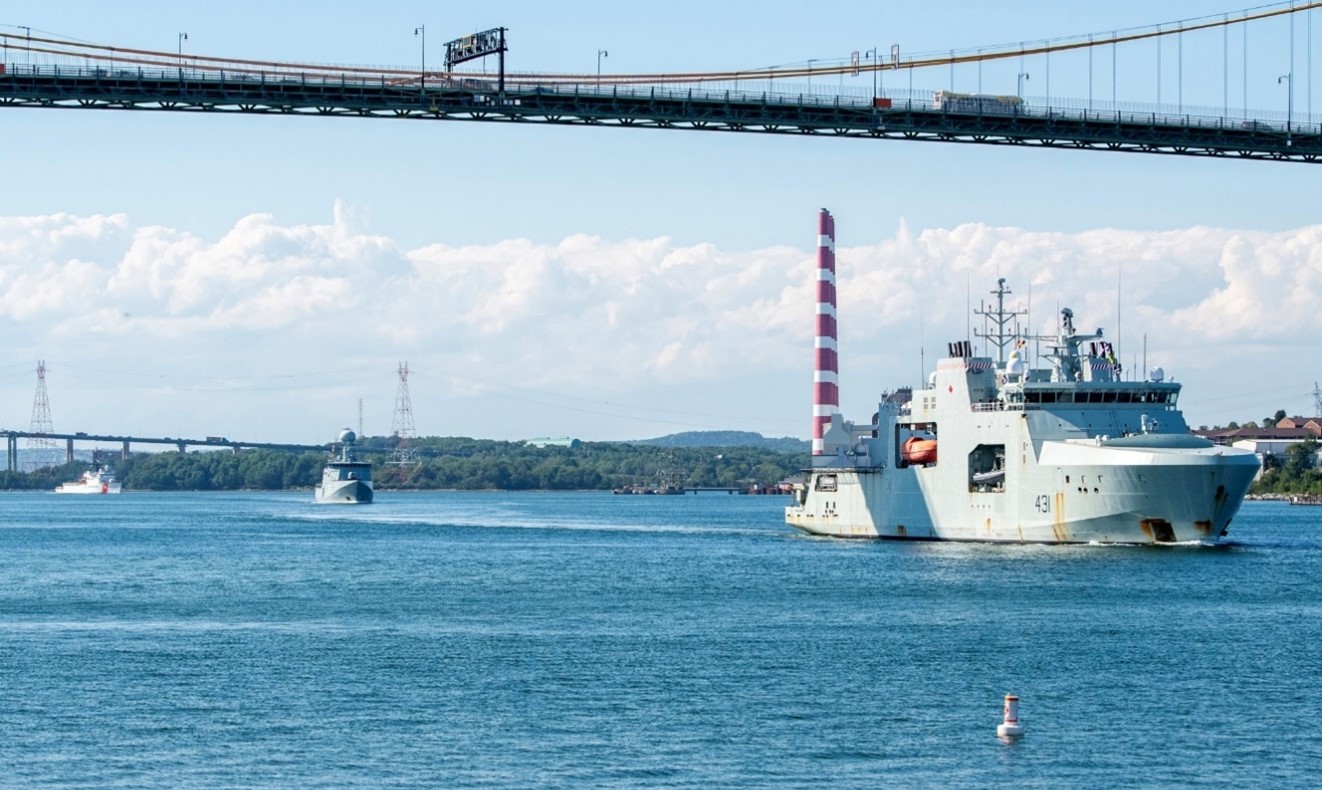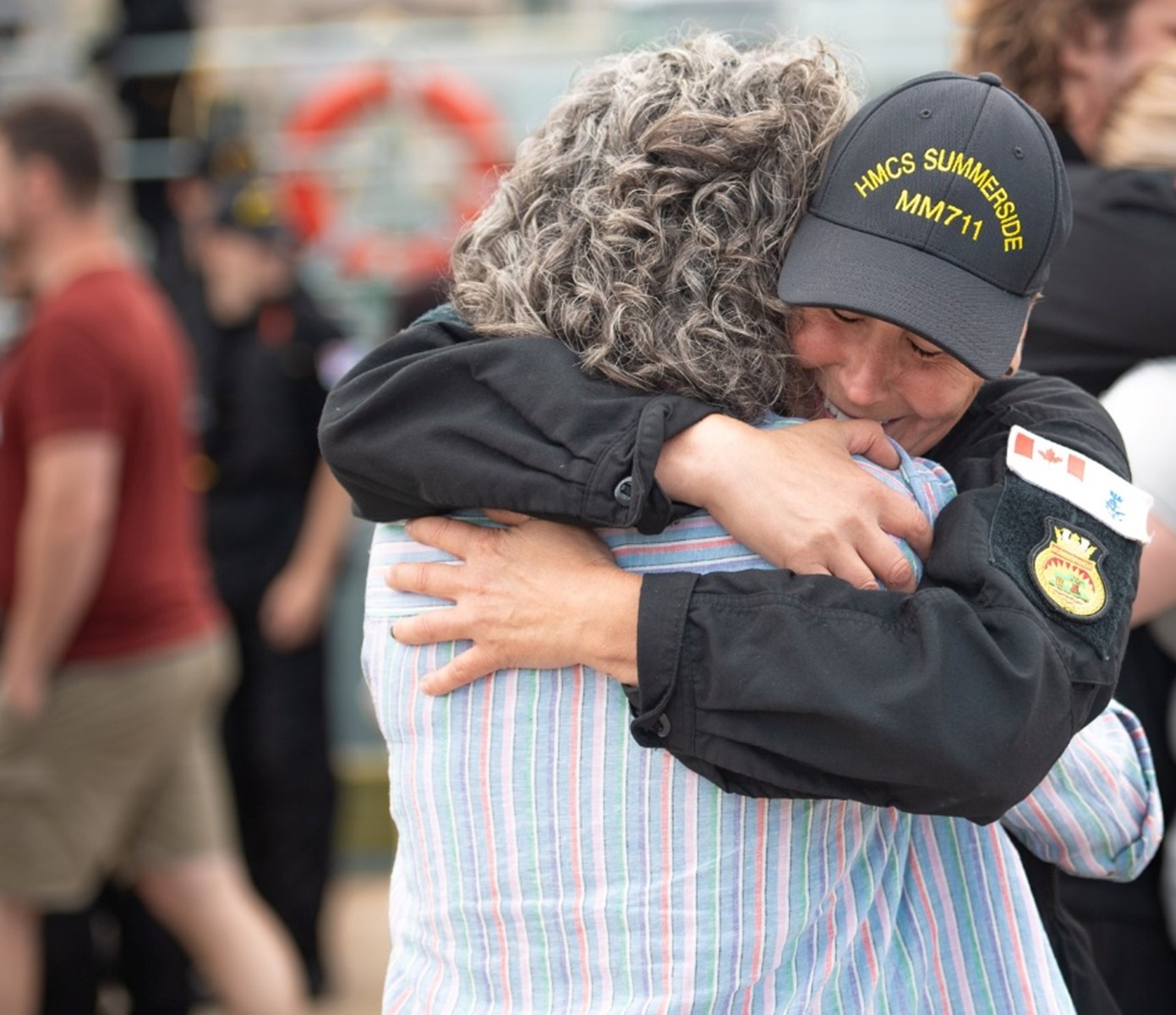Our Navy Today - Volume 7 Issue 6

Volume 7 | Issue 6
Operations update
RCN at RIMPAC 2024: key exercises and record-setting achievements
Caption
The 29th Exercise Rim of the Pacific (RIMPAC) 2024, the world’s largest international maritime exercise, brought together 40 surface ships and 25,000 personnel from 29 nations to Pearl Harbour.
The RCN played a key role in honing military expertise in the Indo-Pacific region while fostering relationships with partners and allies.
HMCS Max Bernays achieved several key objectives, including embarking an allied helicopter, certifying this crucial capability, and enabling humanitarian assistance drills. They were temporarily interrupted by mechanical issues but were able to rejoin the exercise to resume their program. Max Bernays then transited to Esquimalt after valuable force generation exercises enroute and a brief stop for replenishment in San Diego.
HMCS Vancouver participated in a Surface to air Missile exercise, using an Evolved Sea Sparrow Missile to shoot down a US Navy drone missile. After RIMPAC, HMCS Vancouver continued west to Operation HORIZON where it will join HMCS Montréal to enhance resilience and preparedness in support of the rules-based international order.
MV Asterix set new records with 34 Replenishments at Sea (RAS), including first-time refuels with vessels from several nations. Asterix also hosted joint drills with US and ROK special forces, further solidifying Canada’s commitment to international collaboration. The ship will return to Halifax in early September.
HMCS Margaret Brooke departs for Operation NANOOK

Caption
HMCS Margaret Brooke departs Halifax for Operation NANOOK
On August 12th, HMCS Margaret Brooke departed its home port of Halifax to join HMCS Harry DeWolf on Operation NANOOK.
From August to October, the ships will engage in Arctic training, partnership development, and security readiness exercises. They will collaborate with allied nations like the United States and Denmark, as well as the Canadian Coast Guard and Canadian Rangers.
Rear-Admiral Josée Kurtz emphasized the operation's importance in strengthening partnerships and Arctic knowledge. Ongoing since 2007, Op NANOOK shows our capability to operate in the Arctic and enhance maritime domain awareness through presence patrols and cooperative exercises.
HMC Ships Edmonton and Yellowknife depart on Operation CARIBBE

Caption
HMCS Yellowknife sails past Duntz Head and Fisgard Lighthouse as it departs CFB Esquimalt for Op CARRIBBE on August 12.
On August 12th His Majesty’s Canadian Ships (HMCS) Edmonton and Yellowknife departed their home port of Esquimalt, B.C. for a seven-week deployment on Operation CARIBBE in the Eastern Pacific Ocean.
Throughout the deployment, the two ships will work alongside the United States Coast Guard Tactical Law Enforcement Team. Together they will conduct boarding and maritime interdiction operations to track and intercept vessels carrying illicit drugs and goods, aiming to disrupt the flow of these items from South America to North America.
Operation CARIBBE enables the Royal Canadian Navy to work with our partners and allies to protect Canada’s communities through counter-drug operations, and to stop the flow of illicit drugs into Canada, contributing to a safer North America.
HMCS Charlottetown leads multinational exercise in the Mediterranean

Caption
HMCS Charlottetown, flagship of Standing NATO Maritime Group 2, conducts a PASSEX in the Eastern Mediterranean on August 14th.
HMCS Charlottetown, serving as the flagship of Canadian-led Standing NATO Maritime Group 2 (SNMG2), conducted a Passing Exercise (PASSEX) with Japan Maritime Self-Defense Force (JMSDF) ships JS Kashima and JS Shimakaze in the Mediterranean Sea on August 14, as part of Operation REASSURANCE.
Turkish Navy ship TCG Gaziantep and Romanian Navy ship ROS Balescu also joined the exercise.
The PASSEX enabled NATO and partner navies to enhance their mariner skills and demonstrate interoperability through various activities, including maneuvering exercises and communications drills. Sailors from HMCS Charlottetown, ROS Balescu, and JS Kashima participated in a cross-deck exercise, allowing them to visit each other’s ships.
Change of Command for Standing NATO Maritime Group 2

Caption
Change of Command ceremony for Standing NATO Maritime Group 2.
On July 1, Commodore Matthew Coates officially took command of Standing NATO Maritime Group 2 (SNMG2) onboard Charlottetown, supported by a Canadian and international staff.
The Change of Command ceremony which took place at Toulon Naval Base, in France, saw Canada assume flagship duties from France as part of Operation REASSURANCE.
Rear-Admiral Yannick Bossu, outgoing Commander of SNMG2, Vice-Admiral Didier Maleterre, Deputy Commander of NATO Maritime Command (MARCOM), and Commodore Matthew Coates, incoming Commander of SNMG2, participated in the ceremony.
SNMG2 is one of four Standing Naval Forces that operate under NATO Allied Maritime Command. Bravo Zulu to all involved!
HMC Ships Shawinigan and Glace Bay join mine busting Op

Caption
Boatswain aboard HMCS Glace Bay during Operation REASSURANCE.
HMCS Shawinigan and HMCS Glace Bay departed in mid-July for a four-month deployment in the Baltic Sea as part of Standing NATO Mine Countermeasures Group 1 under Operation REASSURANCE.
This deployment underscores Canada’s commitment to international peace and security, supporting NATO objectives in the region through surveillance, monitoring, and diplomatic engagement. The ships will participate in multiple exercises alongside NATO allies, focusing on Historical Ordnance Disposal operations in the Baltic and North Seas.
The deployment includes RCN Clearance Divers and an Autonomous Underwater Vehicle, enhancing the RCN’s operational capabilities. The crews’ mission will contribute to regional stability, highlighting Canada’s ongoing role in NATO’s collective defense measures.
HMCS Summerside returns from Operation CARIBBE

Caption
Sailors reuniting with their families when HMCS Summerside returned home on July 19, 2024.
After an eleven-week deployment on Operation CARIBBE, HMCS Summerside returned home in mid-July.
During the deployment, the crew sailed 10,927 nautical miles, conducted 6 port visits and seized over 800 kg of illicit narcotics while working with the U.S. Coast Guard.
Bravo Zulu to all involved, and a warm welcome home to the crew of HMCS Summerside!
HMCS Montreal stops in Manila to donate food, supplies

Caption
Sailors load donations into a truck for a Community Outreach Activity at the Virlanie Foundation Philippines in Manila, Philippines, as part of Operation HORIZON
HMCS Montréal set sail in April for a six-month deployment to the Indo-Pacific region as part of Operation HORIZON. The ship, carrying 247 sailors, soldiers, and aviators, is equipped with a CH-148 Cyclone helicopter, call sign Strider.
In addition to their operational duties, HMCS Montréal partnered with the Embassy of Canada in the Philippines to donate rice, fans, and school supplies to the Virlanie Foundation Philippines, benefiting underprivileged children. Funds were raised by the ship's crew and embassy staff.
Top Stories
HMCS Harry DeWolf assists disabled vessel near Somerset Island

Caption
HMCS Harry DeWolf on Operation NANOOK.
On July 31, the Joint Rescue Coordination Centre (JRCC) Trenton received a distress call about a disabled vessel near Somerset Island, Nunavut. HMCS Harry DeWolf, conducting Operation NANOOK in the area, was dispatched to assist. The Royal Canadian Navy sailors aboard HMCS Harry DeWolf safely rescued the passengers and crew, escorting the disabled vessel back to Arctic Bay, Nunavut. Thanks to their timely response, all individuals were reunited with their loved ones, and the vessel was safely returned to its home port.
Navy team wins cyber competition
The Fleet Cyber Team (Atlantic) won the prestigious SANS International Services Cup, which took place July 10-11, beating out thirty-five other teams from nine countries.
Congratulations to the team members: Lieutenant-Commander Jonathan Timmins, Lieutenant (Navy) Francis Holtken, Petty Officer First Class Ryan Clifford, Petty Officer Second Class Jake Cotter, and Cody Cools-Lartigue.
Rendez-vous Naval de Québec returns

Caption
Rendez-vous naval de Québec at the Port de Quebec in La Cite-Limoilou in July.
Rendez-vous naval de Québec returned this year for the first time since COVID, featuring ships like HMC Ships William Hall and Fredericton, USS Carney, HMS Protector, and FNS le Rhone.
A dedicated RCN and Naval Reserve team supported the event, offering ship tours, performances by the National Band of the Naval Reserve, and recruiting activities. The Naval Museum of Québec also presented thematic exhibitions, including a new Naval Reserve Centennial mural.
Canada to strengthen arctic security with new submarine fleet
On July 31, the Joint Rescue Coordination Centre (JRCC) Trenton received a distress call about a disabled vessel near Somerset Island, Nunavut. HMCS Harry DeWolf, conducting Operation NANOOK in the area, was dispatched to assist. The Royal Canadian Navy sailors aboard HMCS Harry DeWolf safely rescued the passengers and crew, escorting the disabled vessel back to Arctic Bay, Nunavut. Thanks to their timely response, all individuals were reunited with their loved ones, and the vessel was safely returned to its home port.
Canada is enhancing its underwater surveillance to protect its security and sovereignty. According to the updated defence policy, Our North, Strong and Free, the warming Arctic, heating at four times the global average, is becoming more accessible, raising concerns about foreign military ambitions. By 2050, the Arctic Ocean may become a key shipping route between Europe and East Asia.
Foreign competitors are already exploring Canada’s Northwest Passage and Arctic region, probing infrastructure, and gathering intelligence. Canada needs a new fleet of submarines to protect our sovereignty from emerging security threats. The Honourable Bill Blair, Minister of National Defence, recently announced plans to procure up to 12 conventionally powered, under-ice capable submarines.
The Canadian Patrol Submarine Project (CPSP) aims to enhance the RCN's ability to detect and deter maritime threats, control maritime approaches, and project power on all three coasts. A formal Request for Information will be posted in fall 2024 to engage industry on procurement details.
Canada’s key submarine capability requirements will be stealth, lethality, persistence and Arctic operability; the submarine must have extended range and endurance.
The CPSP is crucial for maintaining Canada's sovereignty and contributing to global security alongside allies.
Up Next
Join us from September 6 to November 9 for the Marine Careers Expo, where you can tour ships, meet crews, and explore career opportunities in the marine industry. This year's event spans multiple locations across Atlantic Canada, the Great Lakes, and the St. Lawrence Seaway. Come aboard and discover the possibilities of a maritime career—your future could set sail here!
Page details
- Date modified: